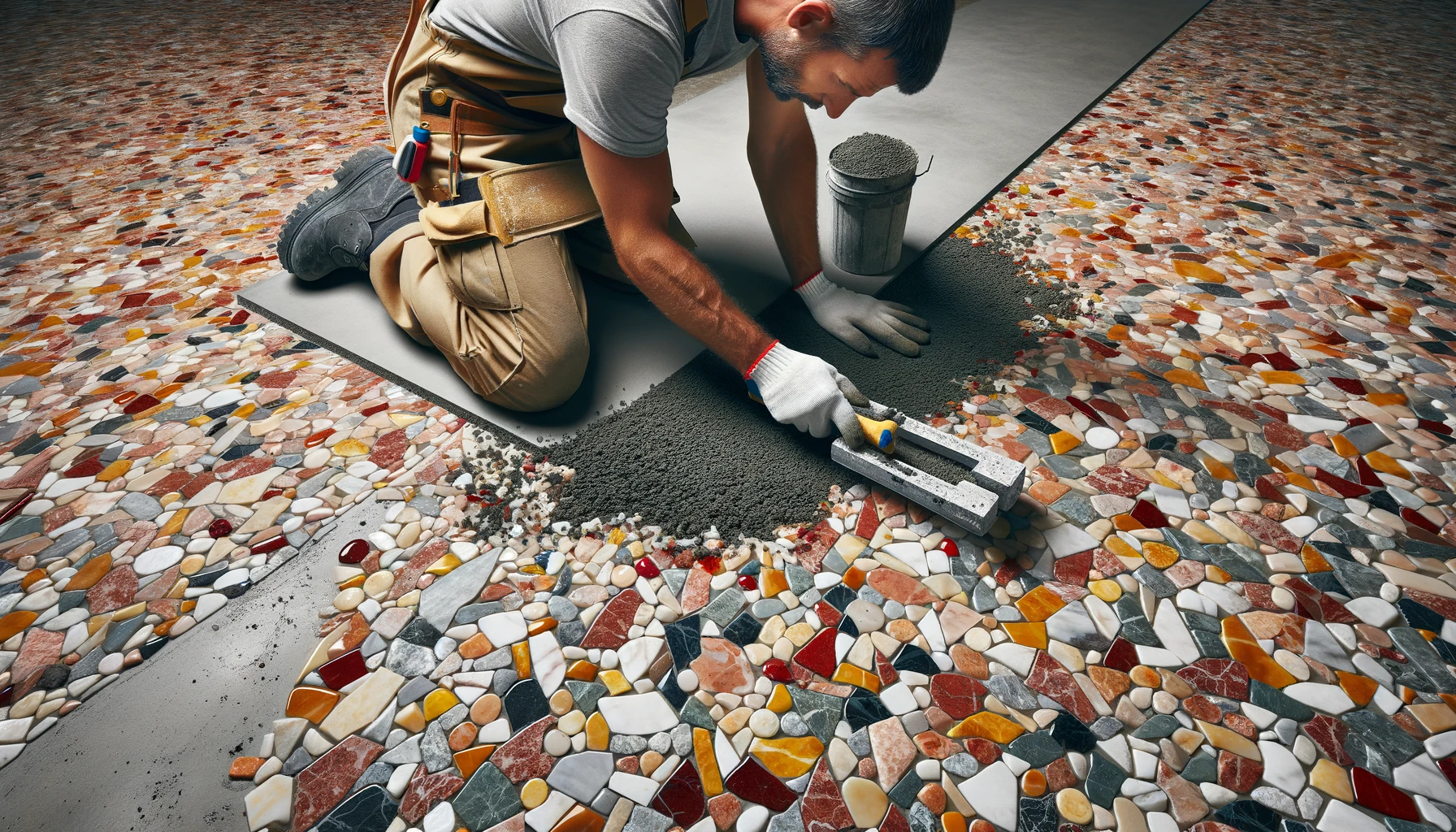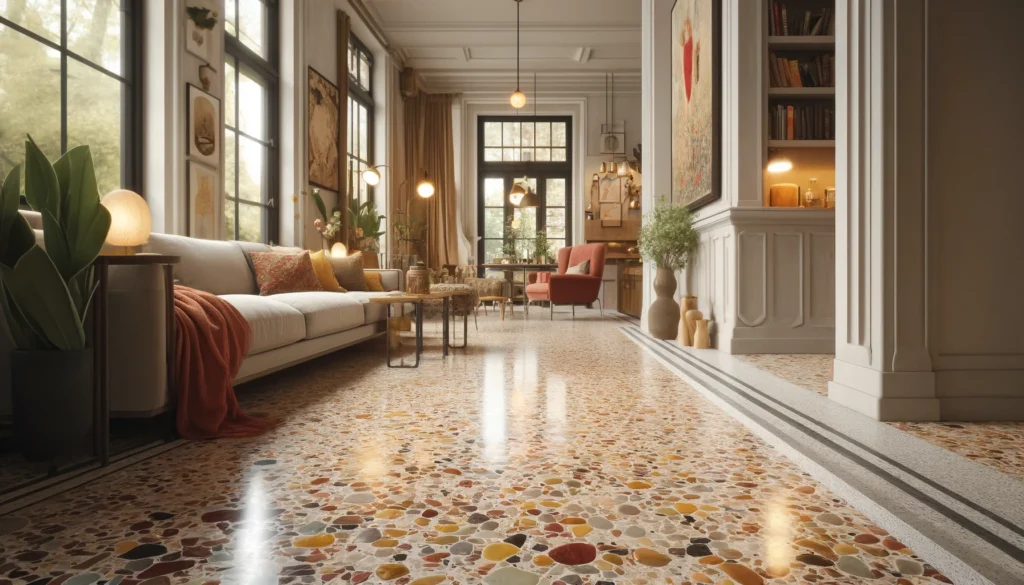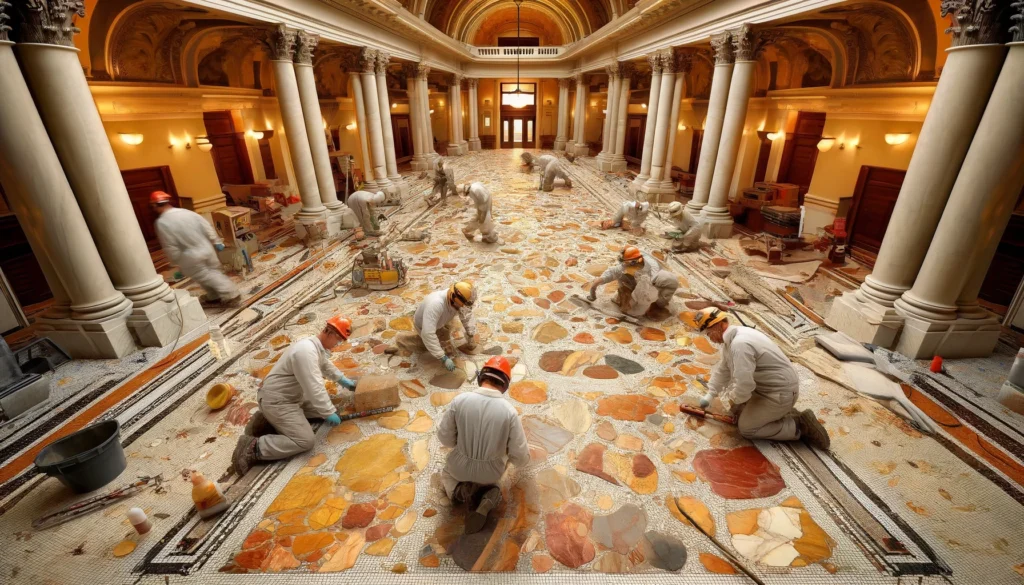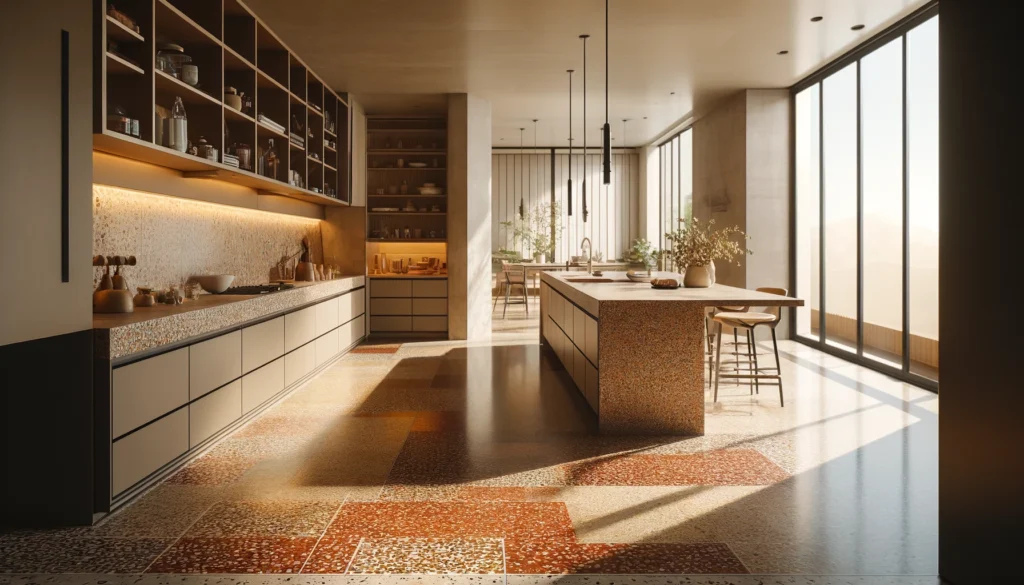In an era where sustainable construction and unique design solutions are becoming increasingly important, terrazzo flooring offers numerous benefits. From residential homes to luxurious apartments, public buildings, and commercial spaces, the applications are nearly limitless. This article highlights the reasons for the resurgence of terrazzo flooring, explores modern uses, and explains why this classic flooring fits perfectly into today’s construction world.
History and Origin of Terrazzo Flooring
How and From What is Terrazzo Made?
Terrazzo Flooring in Modern Construction
Expert Advice: Terrazzo Floors as a Versatile and Durable Solution in Modern Construction
Terrazzo Floors in Renovations of Historical Buildings
Terrazzo Floors in Modern Renovation Projects
Expert Advice: Terrazzo Floors as a Long-Term Worthwhile Investment Despite Variable Costs
Advantages and Disadvantages of Terrazzo Flooring
Expert Advice: The Pros and Cons of Terrazzo Floors in Modern Construction Projects
Checklist: Is Terrazzo Flooring Suitable for My New Construction or Renovation Project?
History and Origin of Terrazzo Flooring
The history of terrazzo flooring stretches far back to antiquity. The Romans first discovered the benefits of this robust and aesthetically pleasing floor covering. Originally, it was a cost-effective solution for reusing marble and stone scraps, mixed with lime mortar and processed into a solid, polishable surface. This technique quickly spread throughout the Roman Empire and was primarily used in public buildings, baths, and villas.
After the fall of the Roman Empire, the technique of terrazzo flooring initially fell into oblivion. It was not until the Renaissance that it truly flourished, especially in Venice. Venetian artisans refined the method and created intricate patterns and designs that adorned the palaces and churches of the city. Terrazzo floors became a symbol of luxury and craftsmanship that has been preserved over the centuries.
In the 20th century, terrazzo flooring was primarily used in public buildings and residential homes. With industrialization came new materials and techniques that eased production and opened up more diverse design possibilities. During the Art Deco movement of the 1920s and 1930s, terrazzo flooring saw another peak as the geometric patterns and color diversity of this era matched perfectly with the aesthetics of terrazzo.
In recent decades, terrazzo flooring has gained popularity once again. Modern architects and designers value the combination of aesthetics, durability, and sustainability that this flooring offers. At the same time, advancements in manufacturing techniques allow for even more precise and creative designs, making terrazzo floors today a choice for a variety of projects, from luxurious private homes to prestigious commercial spaces.
How and From What is Terrazzo Made?
The production of terrazzo flooring has evolved over the centuries but remains at its core a craft process requiring precision and skill. Traditionally, the production starts with a base of concrete or mortar, onto which a layer of stone or marble fragments is applied. These fragments, often available in various colors and sizes, are embedded into the still wet binder and then smoothed out. Once the mixture has dried and hardened, the surface is ground and polished to achieve a glossy, smooth finish.
With advancements in the construction industry and materials science, the techniques for making terrazzo floors have become more modern and efficient. Today, prefabricated terrazzo tiles are often used, manufactured in factories under controlled conditions. These tiles consist of a mix of resins or cement with stone or glass fragments and can be produced in various sizes and shapes. The use of resins allows for thinner and lighter slabs that are easier to transport and install. Prefabricated terrazzo slabs are significantly cheaper to purchase but cannot match the effect of a traditionally laid terrazzo floor.
The materials used in the production of terrazzo floors have changed over time. Originally, mainly marble and limestone fragments were used, but today the possibilities are nearly unlimited. Marble, quartz, granite, and glass are commonly used in various colors and sizes to create interesting visual effects.
In addition to these traditional materials, modern additives are also used to enhance the functionality and aesthetics of terrazzo floors. For example, color pigments can be added to achieve specific shades, or special additives can be used to increase strength and durability. The use of recycled materials, such as glass bottles or industrial waste, contributes to sustainability and makes terrazzo floors an environmentally friendly choice.
Terrazzo Flooring in Modern Construction
oday, terrazzo flooring is found in a variety of new constructions, from residential homes to commercial buildings. Its versatility and aesthetic appeal make it particularly attractive to architects and interior designers looking for durable and elegant flooring solutions.
Residential Homes and Condominiums: In modern homes and luxury apartments, terrazzo floors are often used in entryways, kitchens, and bathrooms. The smooth, polished surface of terrazzo lends a touch of luxury and elegance to these spaces. Additionally, due to its resistance to moisture and wear, terrazzo flooring is particularly suitable for high-traffic areas.
Commercial Buildings such as Hotels, Restaurants, and Offices: Terrazzo floors are also widespread in commercial buildings. In hotels and restaurants, they create a stylish and welcoming atmosphere. In office buildings, terrazzo floors contribute to a professional and modern aesthetic while offering a durable and easy-to-maintain flooring solution.
Terrazzo floors seamlessly integrate into various modern architectural styles, from minimalist to industrial. Their adaptability allows them to be used in nearly any design concept.
Minimalist Design: In minimalist spaces, terrazzo floors emphasize the clarity and simplicity of the design. With their subtle colors and natural patterns, they harmoniously blend into the minimalist aesthetic while providing an interesting visual accent.
Industrial Design: In industrial design, which is often characterized by rough materials and imperfect surfaces, terrazzo floors offer a fascinating contrast. The smooth, polished surface of terrazzo complements the raw texture of concrete, metal, and wood, creating a balanced and appealing overall appearance.
Color and Spatial Adaptation: Terrazzo floors are available in a variety of colors and patterns, making it possible to tailor them to the specific requirements of a project. From monochrome designs to vibrant, colorful patterns, terrazzo floors can be customized to achieve the desired aesthetic effect.
Expert Advice: Terrazzo Floors as a Versatile and Durable Solution in Modern Construction
Terrazzo Flooring in the Renovation of Historic Buildings
Renovating historic buildings: Terrazzo flooring plays a significant role in the renovation and restoration of historic buildings. Due to its durability and aesthetic variety, it is found in many heritage-listed structures.
Preservation and restoration of original floors: In many historic buildings, particularly those from the Renaissance and early 20th century, terrazzo floors are an essential part of the original building fabric. During renovation projects, a major focus is on preserving and restoring these floors. This requires specialized techniques and expertise to maintain the original beauty and integrity of the terrazzo. Restoration work may involve removing stains and cracks, repolishing the surface, and possibly replacing damaged sections.
Adaptation to modern requirements: When renovating historic buildings, there is often a need to adapt the original terrazzo flooring to modern requirements. This may include integrating modern heating systems, such as underfloor heating, or improving sound insulation. Such adaptations must be carefully planned and executed to avoid compromising the historical authenticity of the flooring.
Terrazzo Floors in Modern Renovation Projects
Terrazzo flooring is widely used in modern renovation projects as it bridges the gap between tradition and contemporary design.
Renovating Old Buildings with Terrazzo Elements: In the remodeling of old buildings, terrazzo is frequently used to set new, stylish accents. This can include a complete redesign of floor areas or the insertion of terrazzo elements in specific sections. The use of terrazzo gives the rooms a sense of permanence and class while incorporating modern design aspects.
Integration into Contemporary Living and Workspaces: In contemporary living and workspaces, terrazzo provides an ideal solution for floors that need to be both functional and aesthetically pleasing. The ability to customize terrazzo floors allows designers to select unique patterns and colors that perfectly match the desired room concept. Terrazzo floors can be used in kitchens, bathrooms, hallways, and even in open living areas to create a cohesive and harmonious design
Expert Advice: Terrazzo Floors as a Bridge Between Tradition and Modernity in Construction and Renovation
Terrazzo floors are not only an excellent choice for new constructions but also for renovations and remodeling. Their ability to preserve historical authenticity while meeting modern requirements makes them a preferred option for architects and builders. The combination of durability, ease of maintenance, sustainability, and aesthetic versatility ensures that terrazzo floors will play a significant role in future construction projects.
Cost and Investment Aspects
Terrazzo floors are not cheap. The costs for terrazzo flooring can vary greatly and depend on several factors:
- Material choice: The choice of materials significantly affects costs. Traditional terrazzo materials like marble and quartz may be more expensive than modern alternatives like recycled glass or epoxy resin. Exotic and high-quality materials also increase costs.
- Manufacturing and installation type: Traditional handcrafted terrazzo floors are generally more expensive than prefabricated slabs or modular systems. Craftsmanship requires time and skill, which is reflected in the costs. Installing prefabricated slabs, however, is quicker and less expensive.
- Design complexity: Complex patterns and custom designs increase costs. Simple, single-color terrazzo floors are cheaper than floors with intricate, multi-colored patterns and mosaics. The detail accuracy and precision required for complicated designs also contribute to higher costs.
- Surface area and project scope: The size of the area to be covered with terrazzo affects the overall costs. Larger projects can benefit from bulk discounts, but the total costs are higher due to the larger amount of material and labor involved. Smaller projects may have relatively higher costs per square meter.
- Labor costs: Labor costs vary depending on the region and the expertise of the craftsmen involved. In regions with high labor costs or in projects requiring specialized craftsmanship, costs can be significantly higher. In Switzerland, costs are high compared to abroad.
Terrazzo floors represent a long-term investment that is justified by their durability and minimal maintenance costs:
- Increase in property value: Terrazzo floors can increase the value of properties. Their aesthetic appeal and durability make them a sought-after feature that attracts buyers and increases resale value. Properties with high-quality terrazzo floors can perform better in the market.
- Low maintenance costs: The ease of maintenance and robustness of terrazzo floors lead to low maintenance costs. Compared to other floor coverings that need to be regularly renewed or intensively maintained, the long-term costs for terrazzo floors are lower.
Cost-benefit analysis compared to other floor coverings: Although the initial costs for terrazzo floors may be higher than for other floor coverings such as laminate or carpet, these costs are amortized over time. The long lifespan and the low need for replacement or extensive repairs make terrazzo floors an economical choice.
Expert Advice: Terrazzo Floors as a Long-Term Worthwhile Investment Despite Variable Costs
The costs for terrazzo floors can vary significantly due to material choice, manufacturing and installation type, design complexity, and project size. Despite higher initial costs, terrazzo floors represent a worthwhile long-term investment. Their durability, low maintenance costs, and the potential to increase property value make them an attractive option for builders and property owners. With various financing options and tax advantages for remodeling, the initial financial hurdles can be overcome and the benefits of terrazzo floors fully exploited.
Advantages and Disadvantages of Terrazzo Floors
Advantages of Terrazzo Floors
- Durability and robustness: Terrazzo floors are extremely durable and resistant to wear. They can last for decades, if not centuries, without losing their aesthetic appeal. This makes them a cost-efficient solution in the long run.
- Ease of maintenance: Terrazzo floors are easy to clean and maintain. Regular sweeping and occasional damp mopping are sufficient to keep the floor in good condition. Since terrazzo floors do not have joints where dirt and dust can accumulate, they are particularly hygienic.
- Aesthetic versatility: Terrazzo floors offer almost unlimited design possibilities. By selecting different marble, quartz, granite, or glass fragments and color pigments, individual patterns and colors can be created that perfectly match any design concept.
- Environmental friendliness: Terrazzo floors can be made from recycled materials, making them a sustainable and environmentally friendly choice. The use of recycled glass or stone waste reduces the need for new raw materials and contributes to resource conservation.
- Heat resistance and fire resistance: Terrazzo floors are heat resistant and non-flammable, making them a safe choice for residential and commercial spaces. They contribute to the fire safety of buildings and can be used in areas with high temperatures without problems.
- Individuality and exclusivity: Each terrazzo floor is unique. Since the design possibilities are almost unlimited, each floor can be individually customized, giving it an exclusive and personal touch.
Disadvantages of Terrazzo Floors
- High initial costs: The installation of terrazzo floors can be expensive, especially compared to other floor coverings like laminate or vinyl. The high initial costs are due to the material costs and labor-intensive manufacturing process.
- Installation effort: The installation of terrazzo floors requires expertise and experience, which increases the cost and time required. Manufacturing and installation can take several days to weeks, depending on the area and design.
- Cold sensitivity: Terrazzo floors can feel cold, especially in the winter months. Without underfloor heating or carpets, the floor can be uncomfortable for some users, especially in living spaces.
- Cracking: Despite their durability, terrazzo floors can develop cracks over time, especially if the substrate is not properly prepared or the building settles. These cracks can be repaired, but the repair can be complex and costly.
- Weight: Terrazzo floors are heavy, which must be considered when planning buildings. In older buildings or in buildings with weaker structures, the additional weight can be problematic.
- Sensitivity to certain chemicals: Terrazzo floors can be sensitive to certain chemicals contained in cleaning agents. Acidic cleaners can damage the surface and affect the appearance of the floor.
Expert Advice: The Pros and Cons of Terrazzo Floors in Modern Construction Projects
Terrazzo floors offer a variety of advantages that make them an attractive choice for many construction projects. Their durability, ease of maintenance, aesthetic versatility, and environmental friendliness are compelling arguments. However, the high initial costs, installation effort, and some practical disadvantages such as cold sensitivity and potential cracking should be considered. Overall, terrazzo floors provide a durable and aesthetically appealing solution that is valued in both modern new constructions and renovations and remodeling projects.
Checklist: Is Terrazzo Flooring Suitable for My New Construction or Renovation Project?
Project Requirements and Use: Which spaces will be equipped with terrazzo floors?
- Residential spaces (e.g., living rooms, kitchens, bathrooms)
- Commercial spaces (e.g., offices, restaurants, hotels)
- Public buildings (e.g., schools, hospitals)
What kind of wear will the floors need to withstand?
- High foot traffic
- Moisture exposure (e.g., in bathrooms or kitchens)
- Chemical exposure (e.g., in labs or industrial settings)
Design and Aesthetic Requirements: Does terrazzo flooring fit the desired design concept?
- Minimalist design
- Traditional or classic design
- Modern and bold design
- Desired colors and patterns:
- Solid or natural tones
- Colorful, striking patterns
- Geometric patterns and mosaics
Budget and Costs: Is the budget sufficient for installing terrazzo flooring?
- Material costs
- Labor costs
- Additional costs for special patterns or designs
- Are there financing options or incentives available?
- Sustainability building grants
- Bank financing for part of the renovation costs
- Tax incentives
Technical Requirements and Conditions: Is the substrate suitable for laying terrazzo flooring?
- Stability and evenness of the substrate
- Moisture barrier needed
- Substrate preparation
- What installation techniques are planned?
- Traditional handcrafted installation
- Prefabricated terrazzo tiles
- Epoxy resin terrazzo
Long-term Considerations: What are the maintenance costs and requirements?
- Regular cleaning
- Sealing and polishing
- Repairing cracks or damages
- How durable and robust is the terrazzo flooring compared to alternatives?
- Lifespan and durability
- Resistance to wear and damage
- Ease of maintenance
Sustainability Aspects: Are sustainable materials and manufacturing processes considered?
- Use of recycled materials
- Environmentally friendly production methods
- Does the terrazzo flooring contribute to the building’s energy efficiency?
- Thermal mass and temperature regulation
- Contribution to Green Building certifications (e.g., LEED, BREEAM)
Aesthetic Customization and Individuality: Can the terrazzo flooring be customized?
- Adapting colors and patterns to specific wishes
- Unique designs and exclusivity
- Does the flooring fit the overall aesthetics of the project?
- Harmonious integration into the room concept
- Visual accents and highlights
Safety and Comfort Aspects: Is the terrazzo flooring safe and comfortable for users?
- Slip resistance and safety
- Cold sensitivity and comfort (possible integration of underfloor heating)
- Are there specific requirements for hygiene?
- Antimicrobial coatings
- Easy cleaning and maintenance
Conclusion
Terrazzo floors are experiencing a remarkable revival in modern construction, offering a unique blend of aesthetics, functionality, and sustainability. Their long lifespan, robustness, and ease of maintenance make them an attractive choice for a variety of applications, from luxurious living spaces to commercial and public buildings.
The versatility of terrazzo floors allows them to be used in various design concepts, whether minimalist, industrial, or traditional. Modern manufacturing techniques and materials expand creative possibilities and ensure sustainable construction practices that reduce the ecological footprint.
Although the initial costs and installation effort can be high, terrazzo floors offer long-term benefits and property value enhancements. They contribute to energy efficiency, are easy to maintain, and have a positive impact on the overall value and attractiveness of a building.
Overall, terrazzo flooring is a timeless and future-proof choice that perfectly blends tradition and modernity. Architects, builders, and property owners looking for a durable, stylish, and sustainable flooring solution will find terrazzo flooring an outstanding option for their new construction or renovation project.





